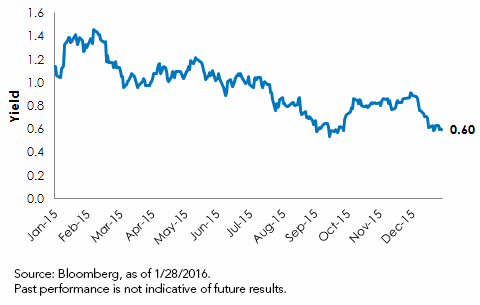The Fed: Not So Great Expectations


 Needless to say, even with the Fed’s recent policy statement in mind, there still seems to be a disconnect between what the market is expecting and what the policy makers are anticipating as the end result. In our estimation, the landscape for U.S. Treasury yields remains one of more range-bound activity and without any significant surge to groundbreaking levels. In fact, with the Bank of Japan’s recent easing move, investors are now presented with two of the world’s largest central banks (including the European Central Bank) having policy rates in the negative territory, a landscape that should continue to support our base case for U.S. rates. As we have witnessed over the last few years, in such an environment fixed income investors can tend to reach for yield by moving too far out on either the maturity or down the credit curve.
WisdomTree feels fixed income investors should consider other ways to enhance their yield. One alternate approach to achieve this goal could be the WisdomTree Barclays U.S. Aggregate Bond Enhanced Yield Fund (AGGY), an exchange-traded fund (ETF) that tracks the Barclays U.S. Aggregate Enhanced Yield Index. This strategy looks to enhance yields relative to the Barclays U.S. Aggregate Index by re-weighting its components to enhance income while broadly retaining its risk characteristics. When utilizing this approach, investors have the potential to stay within a core fixed income strategy and avoid the possible negative effects of “reaching for yield.”
1Press Release of the Board of Governors of the Federal Reserve System, 1/27/16.
Needless to say, even with the Fed’s recent policy statement in mind, there still seems to be a disconnect between what the market is expecting and what the policy makers are anticipating as the end result. In our estimation, the landscape for U.S. Treasury yields remains one of more range-bound activity and without any significant surge to groundbreaking levels. In fact, with the Bank of Japan’s recent easing move, investors are now presented with two of the world’s largest central banks (including the European Central Bank) having policy rates in the negative territory, a landscape that should continue to support our base case for U.S. rates. As we have witnessed over the last few years, in such an environment fixed income investors can tend to reach for yield by moving too far out on either the maturity or down the credit curve.
WisdomTree feels fixed income investors should consider other ways to enhance their yield. One alternate approach to achieve this goal could be the WisdomTree Barclays U.S. Aggregate Bond Enhanced Yield Fund (AGGY), an exchange-traded fund (ETF) that tracks the Barclays U.S. Aggregate Enhanced Yield Index. This strategy looks to enhance yields relative to the Barclays U.S. Aggregate Index by re-weighting its components to enhance income while broadly retaining its risk characteristics. When utilizing this approach, investors have the potential to stay within a core fixed income strategy and avoid the possible negative effects of “reaching for yield.”
1Press Release of the Board of Governors of the Federal Reserve System, 1/27/16.
Important Risks Related to this Article
There are risks associated with investing, including possible loss of principal. Fixed income investments are subject to interest rate risk; their value will normally decline as interest rates rise. Fixed income investments are also subject to credit risk, the risk that the issuer of a bond will fail to pay interest and principal in a timely manner, or that negative perceptions of the issuer’s ability to make such payments will cause the price of that bond to decline. Investing in mortgage- and asset-backed securities involves interest rate, credit, valuation, extension and liquidity risks and the risk that payments on the underlying assets are delayed, prepaid, subordinated or defaulted on. Due to the investment strategy of the Fund, it may make higher capital gain distributions than other ETFs. Please read the Fund’s prospectus for specific details regarding the Fund’s risk profile.


